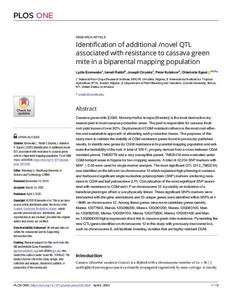| dc.contributor.author | Ezenwaka, L. |
| dc.contributor.author | Rabbi, I.Y. |
| dc.contributor.author | Onyeka, J. |
| dc.contributor.author | Kulakow, P. |
| dc.contributor.author | Egesi, C. |
| dc.date.accessioned | 2020-08-13T14:48:32Z |
| dc.date.available | 2020-08-13T14:48:32Z |
| dc.date.issued | 2020-04-02 |
| dc.identifier.citation | Ezenwaka, L., Rabbi, I., Onyeka, J., Kulakow, P. & Egesi, C. (2020). Identification of additional/novel QTL associated with resistance to cassava green mite in a biparental mapping population. Plos One, 15(4): e0231008, 1-15. |
| dc.identifier.issn | 1932-6203 |
| dc.identifier.uri | https://hdl.handle.net/20.500.12478/6932 |
| dc.description.abstract | Cassava green mite [CGM, Mononychellus tanajoa (Bondar)] is the most destructive dry-season pest in most cassava production areas. The pest is responsible for cassava fresh root yield losses of over 80%. Deployment of CGM resistant cultivars is the most cost-effective and sustainable approach of alleviating such production losses. The purposes of this study were to validate the stability of CGM resistance genes found in previously published results, to identify new genes for CGM resistance in bi-parental mapping population and estimate the heritability of the trait. A total of 109 F1 progeny derived from a cross between CGM resistant parent, TMEB778 and a very susceptible parent, TMEB419 were evaluated under CGM hotspot areas in Nigeria for two cropping seasons. A total of 42,204 SNP markers with MAF ≥ 0.05 were used for single-marker analysis. The most significant QTL (S12_7962234) was identified on the left arm on chromosome 12 which explained high phenotypic variance and harboured significant single nucleotide polymorphism (SNP) markers conferring resistance to CGM and leaf pubescence (LP). Colocalization of the most significant SNP associated with resistance to CGM and LP on chromosome 12 is possibly an indication of a beneficial pleiotropic effect or are physically linked. These significant SNPs markers were intersected with the gene annotations and 33 unique genes were identified within SNPs at 4 – 8MB on chromosome 12. Among these genes, nine novel candidate genes namely; Manes.12077600, Manes.12G086200, Manes.12G061200, Manes.12G083100, Manes.12G082000, Manes.12G094100, Manes.12G075600, Manes.12G091400 and Manes.12G069300 highly expressed direct link to cassava green mite resistance. Pyramiding the new QTL/genes identified on chromosome 12 in this study with previously discovered loci, such on chromosome 8, will facilitate breeding varieties that are highly resistant CGM. |
| dc.description.sponsorship | Bill & Melinda Gates Foundation |
| dc.format.extent | 15 p. |
| dc.language.iso | en |
| dc.subject | Cassava |
| dc.subject | Roots |
| dc.subject | Yield Losses |
| dc.subject | Seeds |
| dc.subject | Loam Soils |
| dc.subject | Sandy Soils |
| dc.subject | Quantitative Trait Loci |
| dc.subject | Mites |
| dc.title | Identification of additional/novel QTL associated with resistance to cassava green mite in a biparental mapping population |
| dc.type | Journal Article |
| cg.contributor.crp | Roots, Tubers and Bananas |
| cg.contributor.affiliation | National Root Crops Research Institute, Nigeria |
| cg.contributor.affiliation | International Institute of Tropical Agriculture |
| cg.coverage.region | Africa |
| cg.coverage.region | West Africa |
| cg.coverage.country | Nigeria |
| cg.coverage.hub | Headquarters and Western Africa Hub |
| cg.researchtheme | Biotech and Plant Breeding |
| cg.identifier.bibtexciteid | EZENWAKA:2020 |
| cg.isijournal | ISI Journal |
| cg.authorship.types | CGIAR and developing country institute |
| cg.iitasubject | Agronomy |
| cg.iitasubject | Cassava |
| cg.iitasubject | Plant Breeding |
| cg.journal | Plos One |
| cg.notes | Open Access Journal |
| cg.accessibilitystatus | Open Access |
| cg.reviewstatus | Peer Review |
| cg.usagerightslicense | Creative Commons Attribution 4.0 (CC BY 0.0) |
| cg.targetaudience | Scientists |
| cg.identifier.doi | https://dx.doi.org/10.1371/journal.pone.0231008 |
| cg.iitaauthor.identifier | Ismail Rabbi: 0000-0001-9966-2941 |
| cg.iitaauthor.identifier | Peter Kulakow: 0000-0002-7574-2645 |
| cg.iitaauthor.identifier | Chiedozie Egesi: 0000-0002-9063-2727 |

